HW44 PCP Pistol
€900.00
Description
HW44 PCP Pistol
The HW44 PCP Pistol stands out as a precision-engineered air pistol designed for shooters who demand accuracy, power, and reliability. Crafted with meticulous attention to detail, it delivers performance that rivals many higher-caliber firearms. Featuring Pre-Charged Pneumatic (PCP) technology, the HW44 ensures consistent shots, minimal recoil, and superior accuracy.
Key highlights include:
-
High-quality construction using robust materials
-
Precision-engineered barrel for optimal accuracy
-
Ergonomic grip for comfortable handling during extended shooting sessions
-
Adjustable sights for precise targeting
-
Quiet operation, making it suitable for both indoor and outdoor shooting
This pistol is suitable for enthusiasts, competitive shooters, and anyone who values reliability and fine engineering in their airgun. Its combination of power, accuracy, and ergonomics makes it one of the most desirable PCP pistols in its class.
Why Choose HW44 PCP Pistol
Selecting the HW44 PCP Pistol means investing in a firearm that balances performance and user comfort. Unlike spring-powered or CO₂ pistols, the PCP mechanism ensures a smooth, recoil-free shooting experience. Every shot feels controlled, precise, and reliable. Additionally, this pistol has a reputation for durability and minimal maintenance requirements, making it a long-term investment for any shooting enthusiast.
Benefits of owning the HW44 PCP Pistol:
-
Consistent accuracy across long sessions
-
Minimal recoil and vibration for steady aim
-
Lightweight yet robust design for ease of handling
-
High-end PCP technology for advanced shooters and beginners alike
The HW44 is more than just a pistol—it represents precision, reliability, and unmatched craftsmanship. Its design accommodates a variety of shooting styles while delivering consistent performance, making it a favorite choice among competitive shooters and collectors alike.
Ergonomics and Comfort
The HW44 PCP Pistol is designed with user comfort as a top priority. Every contour of the grip has been meticulously crafted to fit naturally in the hand, allowing for prolonged shooting sessions without fatigue. Unlike conventional pistols that can feel rigid or awkward, the HW44 accommodates a variety of hand sizes while maintaining perfect balance.
-
Contoured Grip: Designed for natural finger placement
-
Balanced Weight Distribution: Ensures steady aim and control
-
Non-Slip Surface: Enhances grip security, even in humid conditions
-
Adjustable Grip Inserts: Optional customization for personal fit
Transitioning from one shot to the next is seamless thanks to the ergonomic design. Shooters consistently report that the HW44 feels like an extension of their hand, providing unmatched comfort and precision.
Materials and Durability
Durability is a hallmark of the HW44 PCP Pistol. High-grade alloys and precision-engineered polymers are used throughout the construction, ensuring that every component withstands repeated use without compromising performance.
-
Premium Alloy Frame: Resistant to wear and corrosion
-
Rifled Barrel: High-quality steel for long-term accuracy
-
Polymer Components: Lightweight yet strong, reducing overall weight
-
Protective Coatings: Shields the pistol from environmental damage
This combination of materials not only enhances durability but also improves the overall aesthetic. The HW44 maintains its sleek appearance even after extensive use, reflecting the quality craftsmanship synonymous with this model.
Precision Engineering
Every HW44 PCP Pistol undergoes rigorous engineering to guarantee superior performance. The barrel is carefully rifled to optimize projectile stability, while the PCP system is calibrated to deliver consistent shots. This attention to detail ensures that every user experiences the same level of precision, regardless of shooting environment.
-
Calibrated PCP System: Consistent air pressure for uniform velocity
-
Rifled Barrel Design: Stabilizes projectiles for pinpoint accuracy
-
Precision-Machined Components: Ensures smooth operation and minimal friction
-
Tolerances Checked: Each part meets strict quality control standards
The result is a pistol that not only performs flawlessly but also instills confidence in the shooter. Every detail, from trigger pull to shot release, is engineered for optimal control and reliability.
Modern Design Aesthetics
While functionality is paramount, the HW44 PCP Pistol does not compromise on style. Its contemporary design blends modern airgun aesthetics with practical ergonomics, making it appealing to collectors and shooters alike.
-
Sleek Lines: Modern and aggressive design cues
-
Matte Finish Options: Reduces glare and enhances visual appeal
-
Compact Form Factor: Ideal for both indoor ranges and outdoor use
-
Customizable Look: Optional accessories to tailor aesthetics
Shooter feedback often highlights the pistol’s ability to combine performance and style, making it not just a tool, but a statement of quality and precision.
Highlight Bullet List – Design & Build Advantages
-
Ergonomic grip with optional customization for perfect fit
-
Lightweight yet durable construction
-
Rifled steel barrel for superior accuracy
-
Corrosion-resistant frame and components
-
Balanced weight distribution for controlled shooting
-
Modern design aesthetics with functional appeal
-
Low-maintenance materials for long-lasting performance
-
Quiet operation enhancing both indoor and outdoor use
Velocity and Power
The HW44 PCP Pistol delivers consistent velocity thanks to its finely tuned PCP system. Depending on the caliber and tuning, it typically produces a range of muzzle velocities that satisfy both target shooters and small-game hunters.
-
Typical velocity ranges:
-
.177 (4.5 mm): approximately 500–650 fps depending on pellet weight and regulation.
-
.20 (5.0 mm): approximately 420–580 fps depending on pellet weight and regulator setup.
-
.22 (5.5 mm): approximately 380–520 fps depending on pellet weight and tuning.
-
-
Power output: The pistol provides dependable foot-pounds of energy for accurate target work and ethical pest control at reasonable distances.
-
Consistent shot-to-shot performance: Thanks to the regulated PCP system and tight tolerances, velocity swings remain minimal across multiple shots.
Consequently, shooters get the repeatability needed for competitive scoring and the energy required for practical field tasks. Moreover, the HW44’s predictable power curve helps with sighting and ballistic compensation.
Accuracy and Grouping
Accuracy lies at the heart of the HW44’s appeal. The rifled barrel, careful harmonics control, and balanced ergonomics combine to produce tight groupings at practical pistol ranges.
What you can expect on target
-
Short-range precision (5–10 meters): Many users consistently achieve sub-inch groups with premium pellets, thanks to the barrel quality and stable platform.
-
Practical-range precision (10–25 meters): Shooters regularly place shots within small target zones when the pistol is rested or shot off a bag.
-
Consistency across strings: The regulated air supply and smooth shot cycle reduce vertical stringing and help maintain point-of-impact across successive shots.
Because the pistol balances weight and recoil control so well, follow-up shots remain fast while staying on target. Therefore, whether you’re drilling 10-shot groups or practicing timed strings, the HW44 responds predictably.
Trigger and Shot Feel
The trigger assembly on the HW44 aims to provide a crisp, repeatable pull. Engineers designed it for a clean break and short reset, and the result improves shooter confidence.
-
Stage travel: The two-stage or single-stage configuration (depending on the model) allows fine-tuning of first and second-stage engagement.
-
Trigger pull weight: Adjustable within a user-friendly range that suits target shooters and hunters alike.
-
Break quality: Clean, tactile, and deliberately set to minimize creep without sacrificing safety.
-
Reset: Short and distinct, enabling accurate follow-up shots.
Therefore, shooters often mention that the trigger encourages precise timing and predictable releases. In short, good trigger control directly translates into better groups.
Recoil, Vibration, and Shot Cycle
Because the HW44 uses PCP technology, it exhibits very low recoil and minimal vibration compared with spring-powered pistols. The pistol’s shot cycle stays smooth, and the barrel harmonics remain well-controlled.
-
Low recoil: The pre-charged air delivery produces a soft impulse, keeping the sights steady.
-
Reduced vibration: Carefully machined components and tight tolerances damp vibration, allowing pellets to depart the muzzle with minimal disturbance.
-
Quick stabilization: After each shot, the pistol returns to alignment quickly, which helps with rapid-fire accuracy.
Consequently, users notice faster sight reacquisition and improved practical performance in multi-shot drills.
Sound Signature and Suppression
The HW44 offers a quieter experience relative to unsuppressed springers and many CO₂ pistols. Designers optimized the action and integrated shrouding options to reduce muzzle report.
-
Intrinsic quietness: The PCP powerplant keeps the report lower because the air escapes more gradually through tuned ports and shrouds.
-
Optional moderators: Many shooters fit inline moderators or dedicated suppressors to further reduce noise for backyard or early-morning practice.
-
Shooting etiquette: While quieter, always follow local noise and safety regulations when using the pistol.
Thus, the HW44 suits urban practice sessions and discreet fieldwork when used responsibly.
Range and Effective Use
Range performance depends on caliber, pellet choice, and environmental conditions. Still, the HW44 covers the distances relevant for its intended uses.
-
Ideal target range: 5–25 meters for precision target work.
-
Practical pest control range: Up to 20–30 meters for small pests, depending on pellet selection and shot placement.
-
Longer-range capability: With heavier pellets and steady rest, shooters can extend effective accuracy beyond basic pistol distances.
Consequently, selecting the correct pellet and understanding ballistic drop will optimize performance for each application.
Shot Count and Air Efficiency
The HW44 balances power with efficiency so shooters can enjoy multiple quality shots per fill. The exact shot count varies with fill pressure, regulator (if installed), and chosen power level.
-
Typical shot counts: Many builds yield 20–60 effective, consistent shots per fill at target power settings.
-
Regulator benefits: Models with a regulator provide more consistent shot strings and therefore more of the shots fall within the “sweet spot.”
-
Refill considerations: Use a high-pressure hand pump, scuba tank, or on-site compressor to refill. Refill interval depends on usage patterns.
Therefore, for range sessions or fieldwork, the pistol offers predictable performance with reasonable refilling logistics.




Pellet Selection and Ballistics
Pellet choice significantly influences both accuracy and terminal performance. The HW44 performs best with high-quality, match-grade pellets.
-
Light pellets: Increase velocity but may be more susceptible to wind and lose stability at longer distances.
-
Heavy pellets: Offer improved stability and energy retention, making them ideal for pest control at moderate ranges.
-
Hollowpoints vs. domes: Domed pellets usually deliver superior accuracy, whereas hollowpoints may expand more on impact at shorter distances.
Accordingly, experiment with several pellet brands and weights to determine the best match for your pistol’s barrel and your intended use.
Environmental Factors and Tuning
Temperature, humidity, and altitude all influence pneumatic performance. The HW44’s design minimizes these effects, yet careful tuning helps you extract optimal performance.
-
Temperature effects: Cold air reduces pressure; warm air increases it. Adjust shot settings accordingly.
-
Altitude effects: Higher altitude slightly reduces air density; heavier pellets can compensate for stability.
-
Tuning options: Adjust hammer spring (if applicable), regulator settings, and fill pressure to dial in the ideal balance of power and shot count.
Consequently, awareness and small adjustments translate into better on-the-day performance.
Maintenance Impact on Performance
Regular maintenance preserves the HW44’s peak performance. Simple care routines keep accuracy and reliability high.
-
Barrel care: Periodically clean the barrel with non-abrasive tools and avoid harsh solvents that damage rifling.
-
O-ring upkeep: Inspect and lightly lubricate O-rings to prevent leaks and maintain consistent pressure.
-
Regulator checks: Service the regulator per manufacturer recommendations to preserve shot-to-shot consistency.
-
General inspection: Check fasteners, sight mounts, and seals before each session.
Therefore, consistent maintenance reduces malfunctions and helps the pistol retain its factory-tuned accuracy and efficiency.
What is PCP (Pre‑Charged Pneumatic) and why it matters
Pre‑Charged Pneumatic (PCP) systems store compressed air in a reservoir and deliver measured amounts to propel a pellet. Because PCP separates energy storage from the firing mechanism, it eliminates the heavy spring impulse found in springers and avoids the inconsistent pressure drops typical of unregulated CO₂ systems. Consequently, PCP pistols like the HW44 deliver smooth, low‑recoil shots with excellent repeatability.
Furthermore, PCP systems allow fine tuning of power, shot count, and shot consistency through regulators, valve timing, and fill pressure. Therefore, shooters enjoy better accuracy, higher shot quality, and more predictable ballistics. Importantly, PCP requires external high‑pressure filling equipment, but the tradeoff often proves worthwhile for serious shooters.
Core PCP components — a simplified breakdown
To appreciate how the HW44 functions, familiarise yourself with these main PCP parts:
-
Air reservoir (tank): Stores compressed air at high pressure.
-
Fill port / quick disconnect: Allows safe, rapid refilling from a pump or tank.
-
Lever/valve assembly: Controls air release into the firing chamber.
-
Regulator (optional/installed): Maintains a constant output pressure regardless of tank pressure.
-
Hammer/striker mechanism: Releases the valve to let a metered air burst push the pellet.
-
Barrel and rifling: Stabilize the pellet and translate energy into accuracy.
-
Seals and O‑rings: Keep the system leak‑free and efficient.
Together, these elements determine shot‑to‑shot consistency, overall efficiency, and field serviceability.
How PCP produces a shot — step by step
Understanding the shot cycle clarifies why PCP pistols feel so smooth and consistent:
-
Fill: The reservoir receives compressed air from a pump, scuba bottle, or compressor.
-
Ready: Air sits at storage pressure behind the valve and regulator (if present).
-
Trigger: The shooter pulls the trigger; the hammer/striker activates.
-
Valve release: The hammer briefly opens the valve, releasing a calibrated burst of air into the barrel.
-
Pellet launch: Compressed air pushes the pellet down the rifled barrel, imparting velocity and spin.
-
Reset: The valve closes; the system re‑seals and prepares for the next shot.
Thus, a short, controlled valve burst produces the propulsion rather than a mechanical spring, which results in lower recoil and finer consistency.
Regulators — what they do and why you might want one
A regulator acts as a pressure governor between the tank and firing valve. It holds the output pressure steady while the reservoir pressure falls during use. For many shooters, a regulator translates into more usable, consistent shots per fill.
HW44 PCP Pistol Benefits of using a regulator
-
Consistent muzzle velocity: Reduces point‑of‑impact shifts during a string.
-
Improved grouping: Stabilised shot energy often tightens groups.
-
Predictable shot count: Makes it easier to plan refills and practice sessions.
-
Reduced tuning complexity: Limits the variables you must manage to achieve consistency.
HW44 PCP Pistol Tradeoffs and considerations
-
Added complexity: Regulators require servicing and occasional adjustment.
-
Slight weight/space: They increase the pistol’s component count and, sometimes, bulk.
-
Cost: Models with regulators usually cost more or need aftermarket upgrades.
Nonetheless, when precision matters, a regulator often pays dividends.
HW44 PCP Pistol Filling methods — options, pros, and cons
You can refill the HW44’s reservoir using several safe methods. Choose based on convenience, budget, and availability.
Hand pump (high‑pressure PCP pump)
-
Pros: Portable; no dive shop or tank needed; works in remote locations.
-
Cons: Physical effort required; slower fills; potential heat generation during long pumping.
Scuba tank (HPA/SCUBA refill)
-
Pros: Fast fills; minimal effort; widely available at dive shops.
-
Cons: Requires access to scuba services or a large tank; transport and storage considerations.
High‑pressure compressor
-
Pros: Fast, controlled, repeatable fills at home or at the range.
-
Cons: Noise, cost, and maintenance; requires electrical supply.
Fill station / dive shop
-
Pros: Professional fills and advice; minimal user equipment.
-
Cons: Dependent on shop hours and proximity.
Always use a compatible fill adaptor and follow maximum pressure limits specified by the pistol’s manufacturer. Overfilling or using unsuitable equipment risks damage and safety hazards.
HW44 PCP Pistol Safe filling checklist (must follow every time)
-
Verify the pistol’s maximum fill pressure from documentation.
-
Inspect O‑rings and seals for wear; replace if damaged.
-
Use the correct fill adaptor and ensure tight, secure connections.
-
Wear eye protection and maintain a safe stance; avoid direct face exposure to fittings.
-
Fill slowly—especially with hand pumps—to avoid heat buildup and seal damage.
-
Monitor gauges during fills; stop immediately if pressures deviate or leaks occur.
-
After filling, cycle one or two dry shots (without pellet) at a safe direction to stabilise the system.
Following these steps reduces risk and increases the longevity and reliability of your HW44.
HW44 PCP Pistol Valve types and tuning basics
Valve timing, hammer strike energy, and transfer port sizing influence efficiency and shot feel. While advanced tuning falls under gunsmithing, basic adjustments and awareness help optimise performance.
-
Light hammer strike + large transfer port: Efficient for lower power target setups; provides smooth shot feel.
-
Heavier hammer strike + restricted port: Boosts power for hunting, but can cost shot count and increase wear.
-
Balanced setup: Often provides the best combination of accuracy, efficiency, and shot consistency.
If you plan to modify the valve or hammer, proceed incrementally and test thoroughly. Record settings so you can return to a known good configuration.
Common PCP issues and quick troubleshooting
Even well‑made PCP pistols can show minor problems. Here are fast troubleshooting steps paired with likely causes.
-
Loss of pressure between fills: Check for leaking O‑rings at the fill port, reservoir, or valve. Replace seals and test again.
-
Inconsistent velocities: Inspect regulator function (if fitted), verify fill pressure, and test different pellets.
-
Valve not opening / light strikes: Confirm hammer spring and linkage integrity; verify hammer movement.
-
Hissing after fill: Locate and tighten loose fittings; replace damaged O‑rings.
-
Dramatic point‑of‑impact shift during strings: Recheck regulator setting, pellet choice, and seating consistency.
When in doubt, stop using the pistol and consult a qualified technician to avoid damage or unsafe conditions.
Maintenance routines specific to PCP systems
Regular, simple care keeps PCP pistols like the HW44 in top working order.
-
Daily/Before use: Quick visual inspection of O‑rings, fittings, and sight mounts.
-
Weekly (or after heavy use): Clean the barrel gently and cycle seals with light lubrication.
-
Monthly: Inspect the regulator and service per manufacturer guidance.
-
Annual: Full service—seal replacement, valve inspection, and professional check—especially if you use high fill pressures often.
Moreover, store your pistol partially filled (per manufacturer guidance) rather than fully empty to protect seals in many systems. However, follow the HW44 specific manual for exact storage advice.
Advantages and limitations of PCP systems—practical summary
Advantages
-
Extremely low recoil and minimal vibration.
-
Excellent shot‑to‑shot consistency for high accuracy.
-
Tunability via regulators and valve adjustments.
-
Quiet operation compared with springers and many unsuppressed guns.
Limitations
-
Requires external high‑pressure filling equipment.
-
Slightly higher initial cost for regulated systems.
-
More complex servicing than simple spring or CO₂ pistols.
Taken together, PCP technology empowers precise shooting when users commit to proper filling, maintenance, and safe operation.
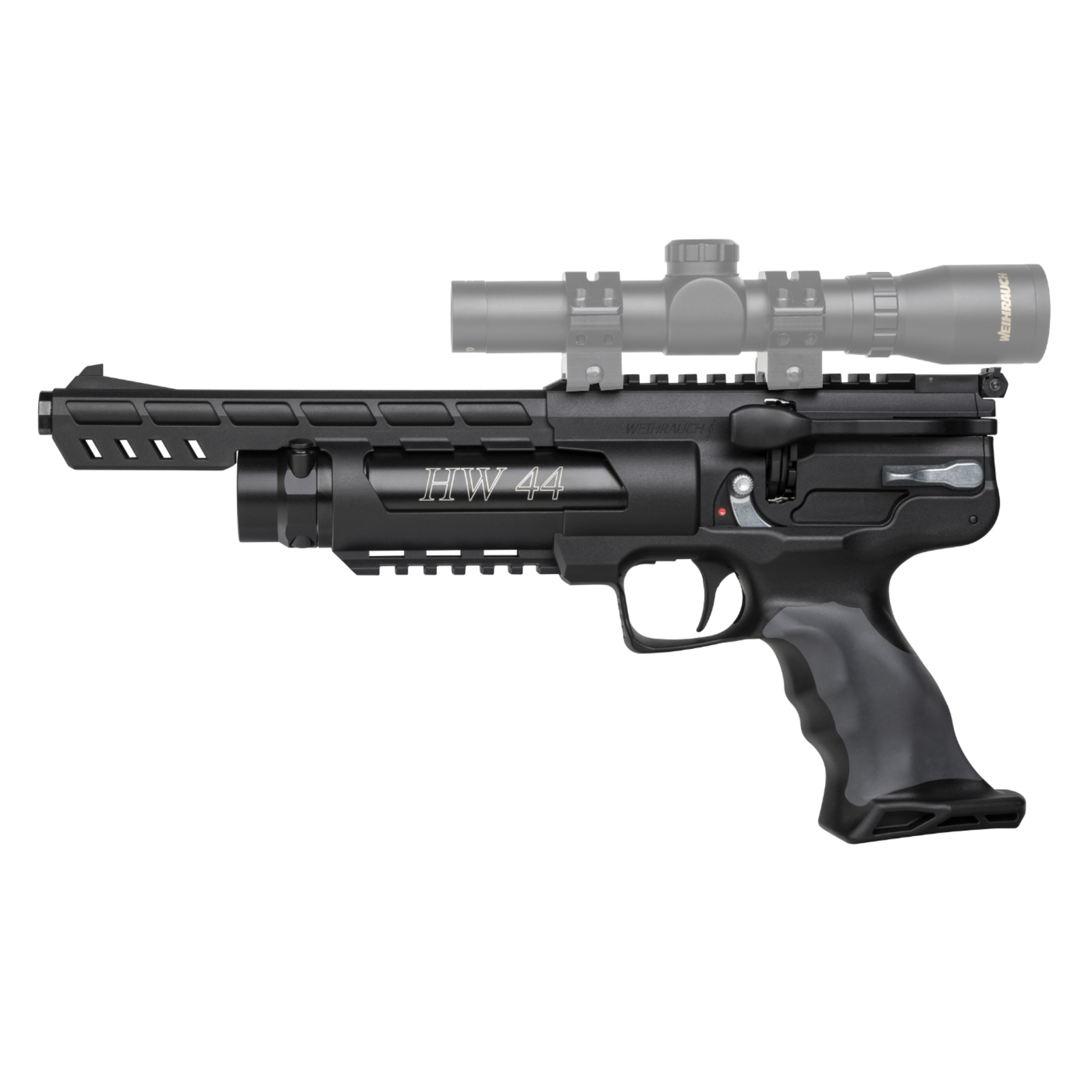
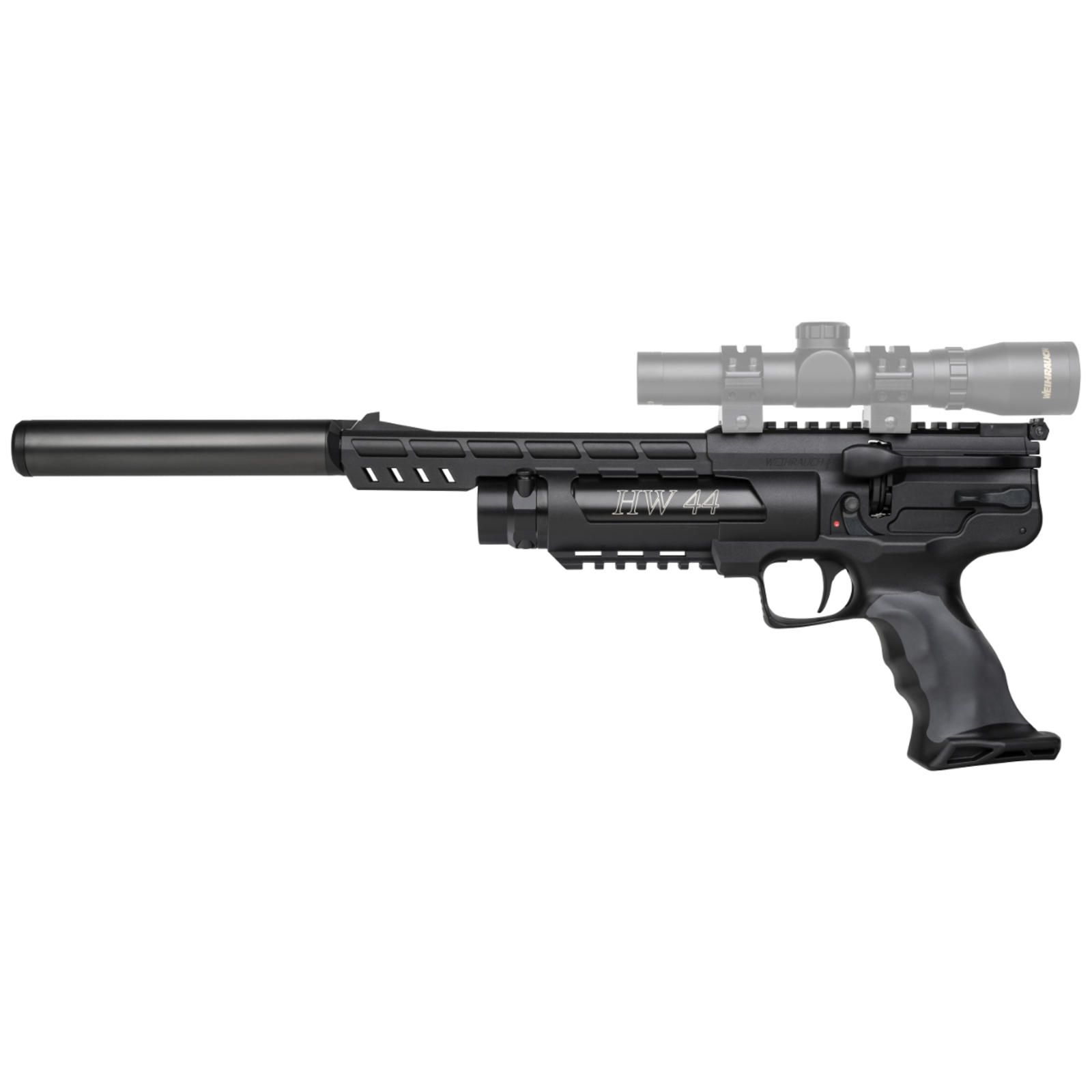
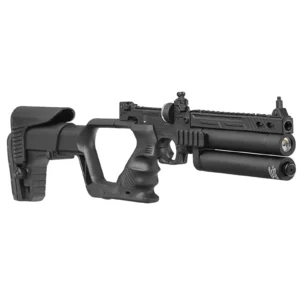
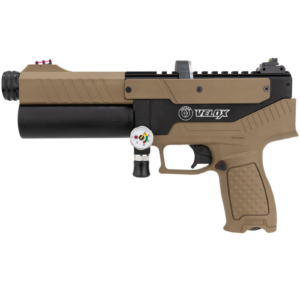
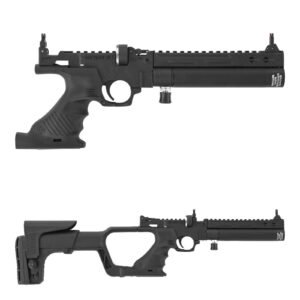
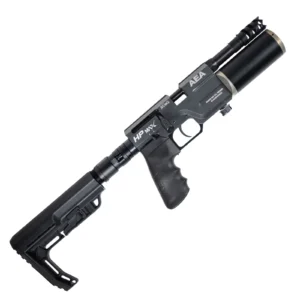
Reviews
There are no reviews yet.